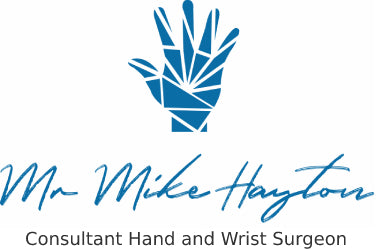Mucus Cyst
Mr Mike Hayton
FRCS(Trauma and Orth) FFSEM (UK)
Consultant Orthopaedic Hand Surgeon
Other common names
None
Who does it affect?
Usually females over 40 years.
Why does it occur?
It is a fluid filled sac, that occurs at the end finger joint (DIP joint), on its back surface to one side or the other. They are caused by a small extra bit of bone around the joint (osteophyte) that occurs as a result of arthritis in the joint. The cyst and bone can cause pressure on the nail bed to cause uneven nail growth.
Symptoms
A small lump that develops on the back of the joint to one side. The joint itself may be stiff and tender. The outline is quite smooth and may feel tense like a small ball or balloon (cystic). The overlying skin may become thin and even breakdown.
Clinical Examination
A mucus cyst has quite typical features both in its location and appearance. In the clinical photograph, the finger shows a classic large mucus cyst. The finger is seen to be bending to one side as a result of more cartilage wear on one side than the other seen in the xray images.

Investigations
An x-ray will usually show wear and tear (osteoarthritis) in the joint. There is often a sharp spike of bone called an osteophyte that is caused by the osteoarthritis.


Non-operative treatment
If it does not cause a problem I recommend leaving it alone.
Operative treatment
If causing problems I usually recommend surgery. The surgery is a day case procedure usually under local anaesthetic and takes about 10-15 minutes. A finger tourniquet is used; which is a small compressive ring around the finger that prevents blood from obscuring the surgeons view.
Local anaesthetic is infiltrated at the base of the finger. Once numb the skin is incised and the skin flap elevated. The ganglion is dissected taking care not to puncture it. The base of the ganglion is identified and excised. A small extra bony area (osteophyte) is seen and needs to be removed. The skin is sutured and a bulky dressing is applied.
Post-operative rehabilitation
The patient is fit to go home soon after the operation. The anaesthetic will wear off after approximately 6 hours. Simple analgesia usually controls the pain and should be started before the anaesthetic has worn off. The hand should be elevated as much as possible for the first 5 days to prevent the hand and fingers swelling. Gently bend and straighten the fingers from day 1. My preference is to remove the dressing at 2 days. The wound is cleaned and redressed with a simple dressing. The sutures are dissolvable and do not need removing.
I usually see patients at 6-8 weeks after surgery to assess the early result.
Return to activities of daily living
It is my advice to keep the wound dry until the wound has healed at 7-10 days.
Return to driving:
The hand needs to have full control of the steering wheel and left hand the gear stick. It is probably advisable to delay returning to driving for a few days until a car can be operated in a safe manner in the event on an emergency.
Return to work:
Everyone has different work environments.
Returning to heavy manual labour should be prevented for approximately 4 to 6 weeks. Early return to heavy work may cause the tendons and nerve to scar into the released ligament. Please ask your surgeon for advice on this.
Complications
Overall, greater than 95% are happy with the result. However complications can occur.
There are complications specific to Mucus Cyst surgery and also general complications associated with hand surgery.
For general complications please click here for specific complications see below
Specific complications:
Recurrence: We are not sure whether it is the same ganglion recurring or simply another one forming nearby. The joint is arthritic and may need treatment in the future.
Nail injury : The nail is very close to the site of the ganglion. Indeed the ganglion can cause pressure on the nail and cause ridging. Surgery can damage the nail and also cause abnormal nail growth but is extremely rare.
